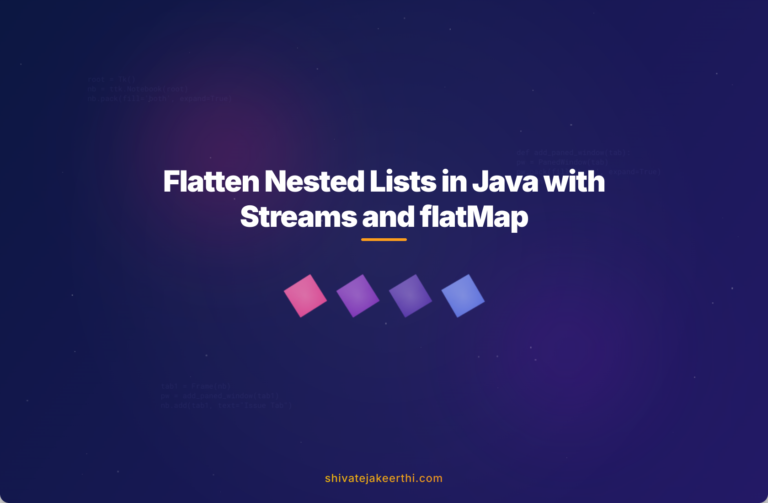Processing complex data structures like nested lists of objects is a common scenario developers often encounter, especially when handling data sets involving companies and their employees. Imagine having multiple companies, each with dozens or hundreds of employees, and your goal is to create a single, flat list of employees along with their associated company information. Doing this manually with traditional methods might become cumbersome and error-prone. Thankfully, Java Streams provide an elegant, clean, and efficient way to address this issue.
Understanding the Problem with Nested Object Lists
Suppose you have a list of Company objects, and each Company contains a list of its Employee objects. For instance, consider a scenario where your application has to retrieve and process the data of hundreds of companies and their respective employees stored in nested collections. Flattening this data structure—extracting each employee and associating that employee directly to a company—can simplify numerous tasks, such as generating reports, performing analytics, or facilitating data visualization.
To make this scenario concrete, let’s define clear Java classes that represent employees and companies, and explore how to flatten such nested lists using the power of Java Streams.
Creating the Java Classes
You’ll start by defining an Employee class:
public class Employee {
private String name;
private String position;
public Employee(String name, String position) {
this.name = name;
this.position = position;
}
public String getName() { return name; }
public String getPosition() { return position; }
@Override
public String toString() {
return name + " - " + position;
}
}
Next, you’ll define your Company class:
public class Company {
private String companyName;
private List<Employee> employees;
public Company(String companyName, List<Employee> employees) {
this.companyName = companyName;
this.employees = employees;
}
public String getCompanyName() { return companyName; }
public List<Employee> getEmployees() { return employees; }
}
The actual piece of data that you will finally extract into a flat list can be represented as a record called CompanyData:
public record CompanyData(String companyName, String employeeName, String employeePosition) {}
Now, let’s populate an example list of companies with some employees:
List<Company> companies = List.of(
new Company("TechSoft",
List.of(new Employee("Alice", "Developer"),
new Employee("Bob", "Tester"))),
new Company("BizInnovate",
List.of(new Employee("Carol", "Manager"),
new Employee("Dave", "Business Analyst")))
);
Introduction to Java Streams and flatMap()
Java Streams is an API that allows functional programming paradigms, offering concise and readable solutions for data processing in Java. One extremely useful method provided by Streams API is flatMap(). It allows you to convert a stream of collections (a nested structure) into a single flat stream.
Think of flatMap() as unpacking multiple boxes (your collections) and placing each content item into a single box for easier access. By applying this technique, your nested lists can transform seamlessly into a flat collection of objects.
Step-by-step Guide to Flattening the Nested List Using Streams
To extract each employee along with the associated company data, you can implement the following Java Stream operation effectively:
List<CompanyData> companyDataList = companies.stream()
.flatMap(company -> company.getEmployees().stream()
.map(employee -> new CompanyData(
company.getCompanyName(),
employee.getName(),
employee.getPosition()))
).toList();
Here’s a quick breakdown of the above code:
- You first create a Stream of companies.
- You use flatMap() to merge the employees of all companies into one unified stream.
- While merging, you map each employee to a new CompanyData record containing employee details along with their company name.
- The result is collected into a simple, easy-to-use List.
Demonstrating the Output
If you now print the results:
companyDataList.forEach(data ->
System.out.println(data.companyName() + ": " + data.employeeName() + " (" + data.employeePosition() + ")"));
You’ll get a clear, flat list of all employees linked explicitly to their company names:
TechSoft: Alice (Developer)
TechSoft: Bob (Tester)
BizInnovate: Carol (Manager)
BizInnovate: Dave (Business Analyst)
Advantages of Using Java Streams
Implementing Java Streams to flatten nested object lists offers significant practical advantages:
- Improved readability: The stream syntax clearly indicates the data transformation steps.
- Concise implementation: Reduces the boilerplate involved with traditional loop constructs.
- Performance and parallel processing: Java Streams enable improved performance by processing data sequentially or concurrently (parallel streams) as required.
What About Traditional Methods?
Can you achieve the same result without Streams? Of course. You could traditionally use nested loops:
List<CompanyData> traditionalList = new ArrayList<>();
for (Company company : companies) {
for (Employee employee : company.getEmployees()) {
traditionalList.add(new CompanyData(
company.getCompanyName(), employee.getName(), employee.getPosition()
));
}
}
While this approach works fine, it is a bit more verbose, cluttered, and less readable. Also, it lacks the easy parallel processing capability of Streams. If you want detailed comparisons of loops and streams, you can read this insightful discussion on Stack Overflow.
Best Practices When Working With Nested Data Structures in Java
To ensure your Java Streams implementation remains robust and maintainable, follow these practices:
- Check for Empty or Null Collections: Utilize methods like stream().filter() combined with checks like Objects.nonNull.
- Employ Descriptive Naming: Keep stream operations explicit to enhance readability and maintainability.
- Be Mindful of Performance: Avoid unnecessary complexity or chaining methods that cause redundant iterations.
Real-world Applications and Scenarios
Flattening nested object structures comes in handy when:
- Creating flat data exports or sending data to APIs in specific structures.
- Performing analytics on large nested data structures collected from different sources.
- Integrating complex data sets for AI, machine learning, or data visualization.
Large enterprises use Java Streams to streamline their data processing, significantly improving efficiency. Companies like Netflix and LinkedIn rely on functional programming styles like Streams for cleaner, high-performing code.
Ready to Try it Out in Your Code?
Using Java Streams and flatMap to simplify complex, nested data processing tasks can save you significant time and improve performance. If you’re interested in other creative coding solutions, explore more articles like these JavaScript tutorials to further expand your skills.
Have you implemented Java Streams effectively in your projects? Let me know your experiences or any interesting scenarios you’ve encountered!



0 Comments